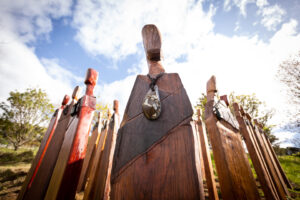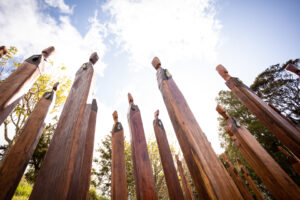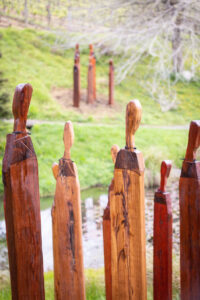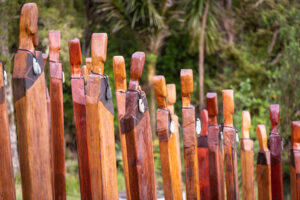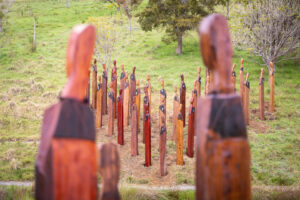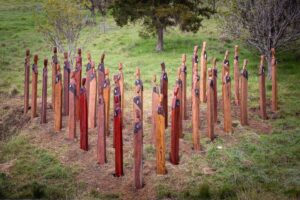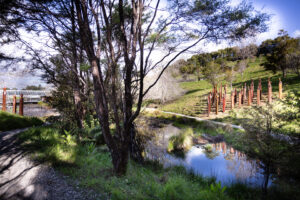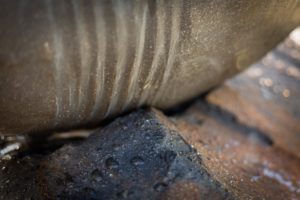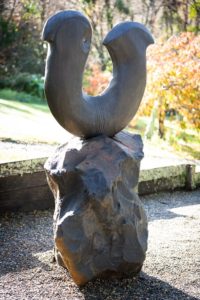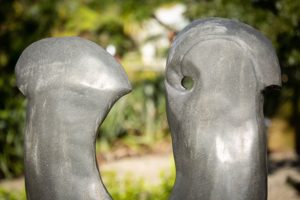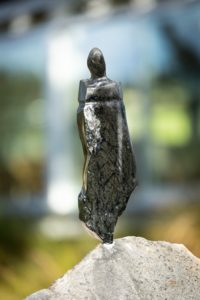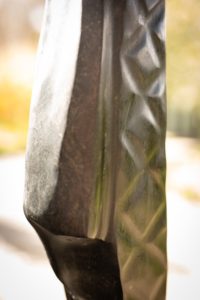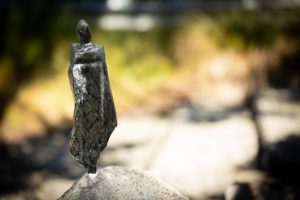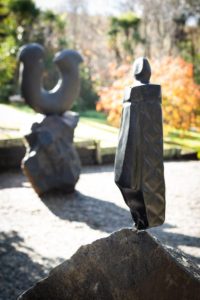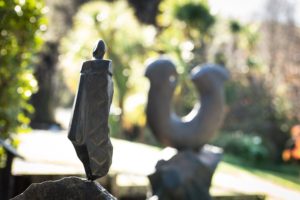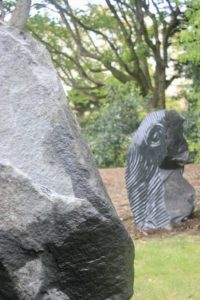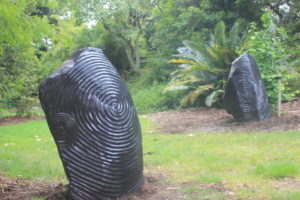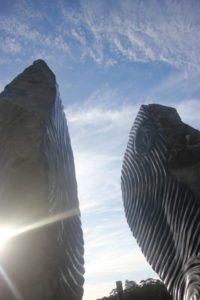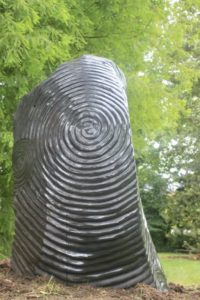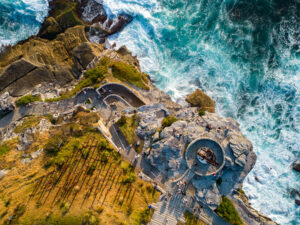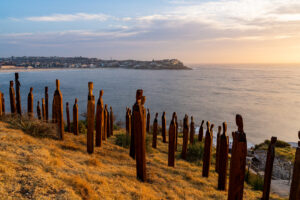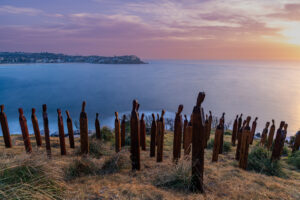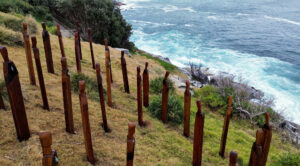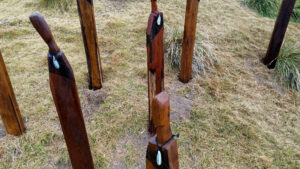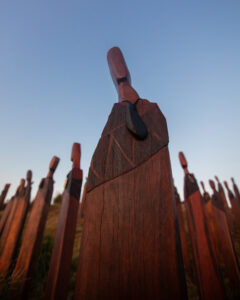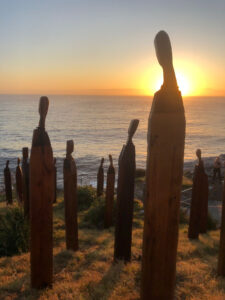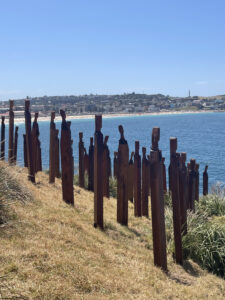NGĀ MANAAKI
Brick Bay Sculpture Trail 2023
Carved over the space of 6 months, Anton Forde’s spectacular Ngā Manaaki is a site-specific installation, inspired by the land and philosophy of Brick Bay.
Composed of a formation of 44 individual contemporary pou with a commanding presence on the hillside, this artwork explores the concept of manaakitanga – a broad and expansive term encompassing the notions of support, care, protection, hospitality, respect and generosity. Perhaps the most profound meaning in the Brick Bay context is the act of caretaking, whether it is for the whenua, for others, or one’s own wellbeing.
As Forde explains: “The whakapapa / genealogy of this work is grounded in the philosophy of Brick Bay…the Didsbury whānau, the whenua, the reality of sustainability and the connecting mahi toi are all relevant aspects when we link the ability to leave a legacy to our whānau and in turn the wider world. At present we are seeing a real shift in our approach to using land and water as a resource. At Brick Bay I feel this approach has been embedded in whenua / land and tangata / people for many years, and the legacy is whakapapa.”
The pou are carved from sustainably sourced Australian hardwoods ((jarrah, ironbark, eucalyptus) and the dazzling spectrum of colour creates movement and vibrancy across the installation. The varying shades give each pou a unique identity, together with the wood grains which roam over the pou like fingerprints. Furthermore, the distinctive poise and pose of each figure, the carved korowai tāniko (cloak design) and the individual pounamu taonga (greenstone pendants) are marks of self-expression and individualism. There is a deliberate move away from uniformity; rather there is a celebration of diversity, and we are reminded that the subtleties of a person such as expression and gesture are what make up their character.
But while each pou evokes the essence of an individual, the emphasis of the installation rests on kotahitanga (unity), and the power of collective formation. Knitted into the earth and following the curvature of the hillside, the pou are carefully positioned into a kao kao (bend or side of the ribs) pattern of Te Arawa and East Coast iwi. Kao kao designs are formed by zigzag lines that create chevrons – a symbolic shape associated with the protection of home and that which is taken by flocks of migratory birds, formations of fighter jet planes and the collective unity of haka action.
Standing at 2.2 metres above ground and gathered above ground level, the pou look over visitors to the site with a gentle watchfulness. Forde describes the pou as having “a feeling of majesty and larger-than-life presence” and there is a distinctly humbling feeling of kaitiakitanga (protection) at play. This results in a strong desire to stand with or sit with the pou in the way one might spend time at a site of memorial – to show up respectfully, with dedication and honour, to pay tribute. Minimal facial expressions in the pou add to, rather than detract from, the character of the work, and in their neutrality we as viewers are able to place our own layers of meaning upon them. This sense of ambiguity allows the space to feel precious and sacred, like spending time with one’s ancestors.
Across the water stands a small gathering of pou – Whānau – creating a conversational synergy between the two groups. This activates not only each lakeside, but the shimmering space between. Reflections dance around the lake as the orientation of site to sun alters, meaning the effects from multiple viewpoints are constantly shapeshifting. There is a sense of magnetism to the water and an anchoring of the pou towards the lake, which references the legend of Ruatepupuke – the grandson of the sea god Tangaroa. Overall, there is a serene balance between land and water, between the individual and the collective. Gazing upon the formation of pou, we are left to ponder – what might we achieve if we all worked together?
In a powerful trans-Tasman partnership, Ngā Manaaki at Brick Bay opened alongside Anton Forde’s Papare/Protection at Sculpture by the Sea, Bondi 2023. Addressing the Pacific Ocean and the elevated headland, Papare also featured a large formation of 60 individual pou, arranged in a kao kao pattern. This is a reference to the two countries and to the ocean that flows between them.
Forde’s hope is that together these works create a symbolic offering of kotahitanga (unity) and whakamaru (protection) for the land and the ocean that connects us.
Tegan Dunn, Brick Bay Sculpture Trail
ARORANGI AND POROTAKA
Brick Bay Sculpture Trail 2023
Tūhonongā
Stand in Many Connections
For me these two kāmaka represent a connection and are a testament to a connection to land / people and belief, whilst walking gently and patiently in whakapono/ faith.
These works build on the two works Rau Aroha and Tū Tika o Nehe. While planning the exhibition at Bentley New Zealand I travelled home to Taranaki and chose a million year old rock and bought it back to Waiheke Island in my truck.
I split the rock and I understood that these particular works mattered and would make a difference. As Kōhatu were shaped and became smooth I was reminded of the rauru pattern that is often associated with Te Ao Mārama/ the world of light; two worlds in one, or a pebble dropped in a pool that ripples out, or the stone walls I had seen in the Gaeltacht and Otago Peninsula. I also thought of the Toroa/ Albatross colony at the end of the Peninsula and decided to carve a rauru which represents both journeying and the embrace of two elements around a central space of energy. I kept chipping away and I kept sanding.
I carved three smaller rauru designs on each rock to connect with our Raukura/ feather which links to peace with God/Atua, Whenua/ Land and Rangimarie/ Peace.
After the Kāmaka exhibition was blessed at Bentley, Michael Steedman and I met with Stanley, caretaker at Old Government House for the past 35 years, and he shared a story of his whānau, whakapapa and of two rakau / trees in the grounds. One was from the Governor General and the other is the moko / grandchild of Tane Māhuta. Stanley placed the Tūhononga stones on either side of the entranceway to these most beautiful trees.
Personally they have allowed connection and reconnection on a wairua whakapapa / spiritual and belonging level.
5 December 2022
Papare / Protection
Sculpture BY THE SEA BONDI 2023
Forde was one of two NZ artists selected to exhibit at Sculpture by the Sea, Bondi 2023, which celebrated its 25th exhibition from 20 October – 6 November. The world’s largest annual free-to-the-public outdoor sculpture exhibition featured over 100 artworks from Australian and international artists along the spectacular 2km Bondi to Tamarama coastal walk. One of Australia’s leading cultural events, Sculpture by the Sea, Bondi attracts 450,000 visitors over the course of 18 days and signals the beginning of summer in Sydney.
Forde’s 25m2 installation, Papare / Protection features on the Marks Park peninsula at Bondi, addressing the Pacific Ocean and the elevated headland. Papare features 60 individual pou / contemporary sculptures of 2.7m tall larger-than-life male and female figures installed in ten groups of six representing a kao kao pattern. Anton Forde’s Pou are time-travelling sentinels. All-seeing, all knowing, listening, individually and collectively they stand as guardians and protectors. Papare/Protection builds on the idea that each individual Pou can make a beautiful statement whilst also making a statement as a whole work. For this work the kao kao raranga/weaving is created by assembling 60 Carved/ sculpted hardwood 2.7 meter tall Pou sculptures installed in ten lots of six in a V formation which links to the haka formation of protection, or birds migrating. The V or kao kao formations are clearly visible from the sky, sea and land and together present a dominating and sheltering presence on the exposed headland. Forde says,
“Walking among them, we might take measure of our smallness in relation to the majesty of nature, of time, and of the many generations of people to have come before and who will come after.”
Ngā Manaaki is installed at Brick Bay Sculpture Trail in Matakana from October 2023. This work features 39 Pou in a single kao kao arrowhead formation on a sloping site, facing 5 “Pae Pae” Pou on the facing bank on the other side of a pond. The pattern is associated with protecting home.
The artist hopes the 39+5 kao kao sculpture at Brick Bay and the 6×10 kao kao sculpture at Sculpture on the Sea Bondi 2023 together create a symbolic offering of kotahitanga – unity – and whakamaru – protection – for the land and the ocean that connects us. The artist, drawing upon his knowledge and connections, hopes these works inspires us,to conceive of ourselves as kaitiaki or guardians of the land and sea, rather than as possessor or exploiter. Anton Forde says
“with these works, my hope is to bring attention to the need for us to unify to protect Te Ao / our world for future generations. I hope these works connect us to our whenua / land and
moana / oceans in a way that makes us want to do more to protect them.”
